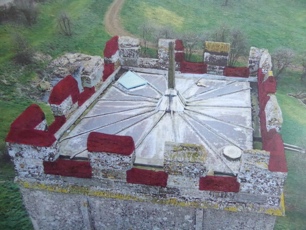Era
Year
National / World Events
Stowe Nine Churches Events
Prehistoric
<43AD
Neolithic
4000BC to 2000BC
People
took up agriculture as a way of life, and stopped being nomadic
hunter-gatherers.
Neolithic farmers settled in stable
communities, cleared land, planted wheat and barley, and raised
herds of domesticated sheep, cattle, and pigs.
Stonehenge was built
The church of St Michael’s is built on a Neolithic worship site.
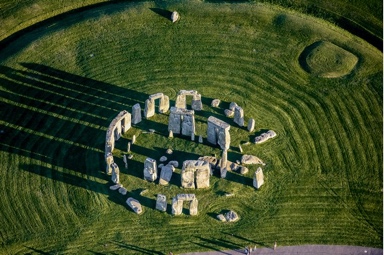
800
BC to
43AD
The Iron Age in Britain. A tribal culture prevailed based on warrior Kings and Hill Forts. Iron (found locally) was made into tools. The Roman invasion brought fragmented kingdoms under central control and arguably the beginnings of a nation state
Castle Dykes, the English Heritage site just beyond Stowe Wood - Castle Dykes and Castle Yard are thought to have been of Iron Age origin.
In
1973 the Department of the Environment dated them as 400 BC to 50
AD.
The nearby Borough Hill was a large Iron Age fort which may
have had earlier Bronze age origins.
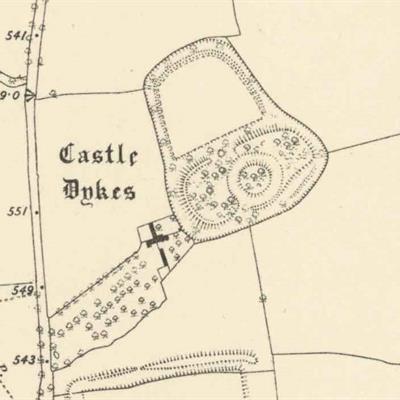
Roman
Britain
43 AD to 425 AD
The Roman empire extends to most of southern Europe, the Levant and North Africa. England was occupied from AD43.
The Romans made Towcester a garrison town and called it Lactodorum
The
Romans build Watling Street, the present A5, and may have built a
Temple on the site of St Michael’ Church. One of the stones
kept in the Church is thought to have come from Rome.
A
Roman ring was found by Freda Stanley at The Bank house in the
late 20th century.
And in 2019 a Roman coin bearing the impress of Empress Helena, mother of Constantine the Great is found in Upper Stowe by Chris Pratska. Constantine made Christianity the religion of the Roman Republic and lent his name to the City of Constantinople, formerly Byzantium
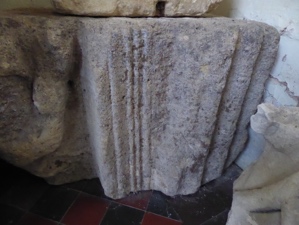
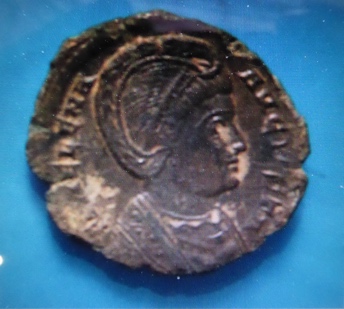
Roman
Britain
43 AD to 425 AD
AD60/61
Roman rule is consolidated, towns, villages and Roman Villas are built, a highways infrastructure built along with fortifications. The rule of law is codified and implemented. Warring native tribal factions are suppressed. Indigenous people move to Wales
The Battle of Watling Street AD 60/61.
Land to the north of Church Stowe has a strong claim to be the site of Boudicca’s last battle, popularly known as the battle of Watling Street, which took place in AD 60/61. This battle ended the native rebellion against Roman occupation.
Local tradition has it that Boudiccia committed suicide by taking poison in Stowe Woods when it became clear that the battle was lost.
A mound to the right of the steep road leading out of Weedon may be the burial ground for the battle.
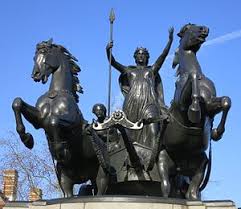
700
At the monastery of Lindisfarne, Northumbria, work on the famous richly illustrated edition of the Gospel was started
A religious hermit called Alnoth may have been buried near, or on the site of St Michael’s in the early 8th century and a festival kept to his memory. He is believed to have died in 700 AD murdered by two robbers. Anglo-Saxon carved stones found in the churchyard suggest early Christian activity and may have been a result of a cult in his name that developed at the burial site – the cult of St Werburgh and St Alnoth.
(St Werburgh was a nun living in Weedon Bec.)
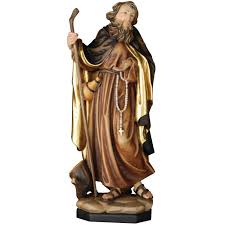
Anglo-Saxon
c 500 to 1066
After the Romans had left Britain their civilising culture continued to influence the period
The feudal system prevailed headed by the Lord of the Manor who held allegiance to the Monarch.
The age of Chivalry in Europe. King Arthur and the legend of the courtly Knights emerge.
The oldest part of St Michael’s Church including the tower or belfry was built in this era – c. 950 – 1100 - most probably in 956 AD,
The structure of The Manor existed at this time, probably on its present site, but occupying a smaller footprint and of timber construction
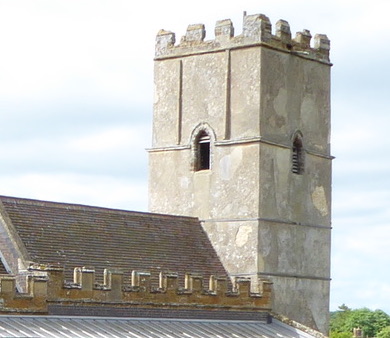
Norman
1066 - 1154
1066
Harold II dies at the Battle of Hastings.
Anglo-Saxon rule ends with the arrival of William the Conqueror who is crowned King of England in Westminster Abbey on Christmas day
Church Stowe is recorded in the Domesday book as having 27 houses, 10 ploughs and woodland.
Gilbert de Ghent, nephew of William the Conqueror becomes Lord of Stowe. He and his descendants occupy the Manor (except for a short period), until 1715.
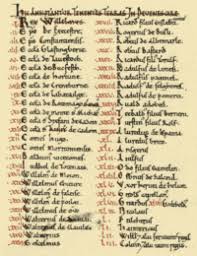
22nd Aug 1138
Gilbert’s eldest son Walter was an officer in command at the famous battle of the Standard against the Scots at North Allerton in Yorkshire and is said to have gained the victory through his prudence and conduct.
Plantagenet
1154
- 1485
1337 to
1453
The Hundred Years War - a series of conflicts with France about the right to rule France
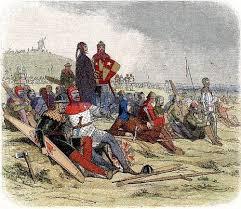
16th Mar 1322
Warine de Lisle, then Lord of the Manor of Stowe, took up arms against the King under the command of Thomas, Earl of Lancaster and was taken prisoner with him at the Battle of Boroughbridge in Yorkshire, he was executed a week later. His property was forfeit.
26th Aug 1346
June 1348
The Battle of Crecy – one of the most famous battles of the Hundred Years War – took place in NE France between a French army and an English army,
The Black Death, a bubonic plague pandemic reached England.
Gerald de Lisle (1304-1360), son of Warine was restored to his father’s possessions in 1327.
Sir Gerald, a Crusader Knight - helped Edward III defeat the French at Crecy.
He is a descended from Gilbert of Gaunt, whose family held the Manor since the Conquest in 1066.
His long and impressive tomb in Purbeck marble has lain in the Church since 1370. It is exquisitely carved and of very fine quality
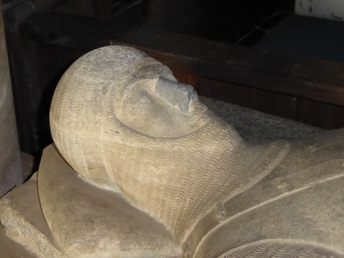
Plantagenet
1154
- 1485
1390
A bell bearing the date 1390 is installed in St
Michaels. It is currently on the ‘Schedule of Bells for Preservation’
1439
The Manor of Stowe was inherited by Elizabeth, wife of George Neville, Lord Latimer
1455 to 1485
War of the Roses – a series of English Civil Wars between the two rival branches of the royal House of Plantagenet: House of Lancaster (red rose) and the House of York (white rose)
The Neville family played a central role in the War of the Roses - on the side of the House of Lancaster
Tudor
1485 - 1603
July 1543
Henry VIII marries Catherine Parr
One of the descendants of Lord Latimer was John, 3rd Baron Latimer, whose second wife Catherine was the daughter of Sir Thomas Parr.
Henry VIII visits the Manor to court Catherine Parr who had inherited The Manor. She was renowned for her astuteness and was thought to have acted as Henry’s Regent whilst he was away in France. Having outlived Henry by a year, she died in1548 and received the first Protestant funeral in England
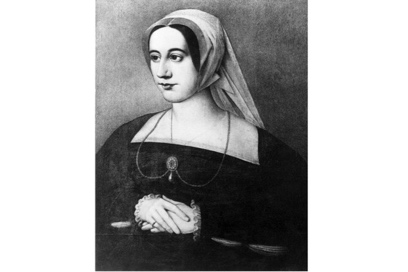
The Mayflower sets sail from Plymouth Harbour in 1620.
Act of Union between England and Scotland 1707
Elizabeth Lady Cary (1546 – 1630) who lived at The Manor was one of the outstanding women of her time. Her tomb lay in the church some years before her death and was carved by Nicholas Stone, the leading sculptor of the day It is described in the Pevsner Architectural Guides: Northamptonshire as “one of the greatest masterpieces of its age”.
She died aged 84 years, having lived through the entire reign of both Elizabeth 1 and James 1.
Aubry said of her that she was a wit, as good a manager as any man, exceptionally beautiful but vengeful.
She was the step grand-daughter of Catherine Parr.
In the 1960’s her tomb was opened to see if any items of literary interest had been buried with her to no result. She was a close friend of William Shakespeare.
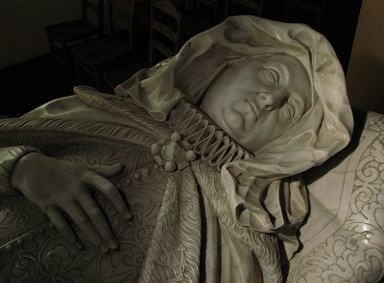
Tudor
1485 - 1603
1601
In February 1601 Sir Charles Danvers (Lady Carey’s first son) took part in Essex' short-lived rebellion, and was convicted of treason. He was beheaded on Tower Hill on 18 March 1601.
Stuart
1603
- 1714
1639
Lady Cary’s second son Henry succeeded to the Manor of Stowe and was created Earl of Danby by Charles 1. He died in 1643 having repaired and enhanced St Michael’s church in 1639 at his own expense. The square-headed windows with plain mullions were introduced at this time. Also, Box Pews, Three Decker Pulpit, Gallery and a Medieval Font all of which were removed in 1859 when the church was again remodeled.
Georgian
1714
- 1837
1716
Congress of Vienna 1714 - 1715.
Peace of Utrecht, end of the Spanish War of Succession
1716 the death of Dr Thomas Turner, President of Corpus Christie College, Oxford University.
He leaves his fortune which amounted to £36 million at today’s prices, to the Corporatio of the Sons of the Clergy. The charity was founded in 1655 and was established to provide for destitute clergy and their families during the time of Oliver Cromwell. The Corporation bought the estate of Stowe for £15,500 as an investment. Over the next 200 years the Sons managed the estate carefully for the benefit of both the clergy and local people relinquishing it in 1916.
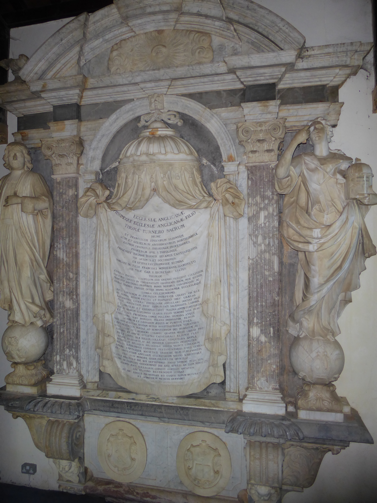
1736
The Rectory now known as Wyndham House was built.
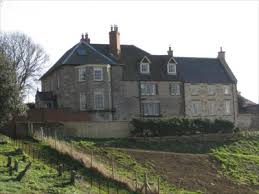
1800
1830
The
industrial revolution starts in Britain and spreads to Europe and
North America.
It is preceded by the agricultural
revolution which introduced mechanisation to farming
The Grand Union canal is built nearby along with the London to Manchester Railway. These works alter the topography significantly in the NE of the village and would have affected village life by providing alternative employment opportunities
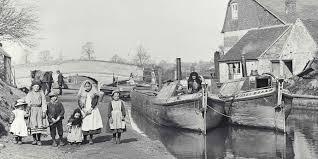
Victorian
1837 to 1901
Queen Victoria reigns for 63 years.
Great Britain is the dominant world power
The Crawley family were associated with Stowe as Rectors for 200 years. Dr John Lloyd became Rector in 1754, his sister married a Crawley and his descendent, Henry Hugh Crawley died in 1921.
The Crawley Family bring great benefits to the villages.
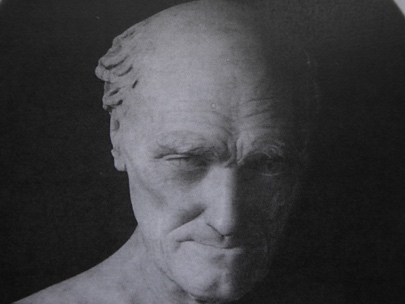
1841
1855
1859
The village school is opened
The chapel of ease, St James’s in Upper Stowe is built by Philip Hardwick
St Michael’s is restored and altered at a cost of £1,200 to include the installation of the Bath Stone Pillars, Raised Roofs, Choir Stalls, Pews, Font and the Altar
All commissioned by the Rev Henry Crawley
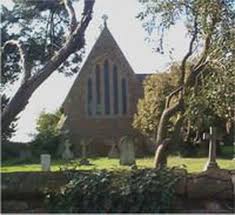
A limestone quarry was established to the south of the road from Church Stowe to what is now the A5. It was linked by a horse worked tramway which led under the main railway to the canal between Nether Heyford and Weedon. The limestone quarry ceased operation in 1990.
Edwardian
1901
- 1914
The United States becomes the world’s leading economic power.
Rural life continues almost unchanged.
Agriculture is the predominant source of employment. Most households grow their own vegetable, keep a pig or have a share in one and game is widely shot to supplement what must have been a substantial diet. Beer was brewed at The Maltings next to the Church. Tractors had not replaced horses. Few were able to travel by horse drawn coach other than the Rector.
First
World War
1914
- 1918
World War I
Battle of the Somme 1916
Treaty of Versailles 1919 marks the end of the Great War
The Stowe estate amounting to 3289 acres is sold at auction by Bidwell’s on behalf of the Sons of the Clergy, owner since 1715. The property included the Stowes, parts of Litchborough, Nether Heyford, Weedon and as a separate unit, Adstone.
The sale took place in 1916 - take a look at the original Bidwells catalogue of all 52 lots.
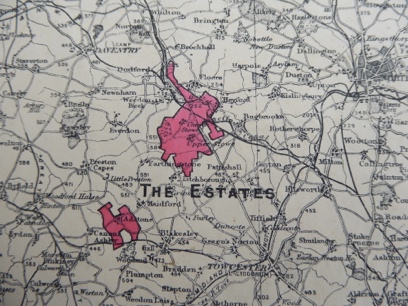
A memorial to those who died in the Great War is erected at Church Stowe
Those who lost their lives:
Capt Crawley; Pte Colley; Gnr Colley; Pte Muskett; Pte Newton; Pte Sharp; Bombr Tomlin; Bombr Tomlin
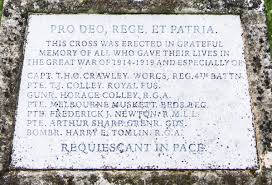
14th Aug 1915
The 08:45 Birmingham to Euston express passenger train and the 08:30 Euston to Holyhead Irish Mail train crashed between Weedon and Stowe Hill tunnel. Both locomotives and every carriage were derailed; killing 10 passengers and injuring 21 more.
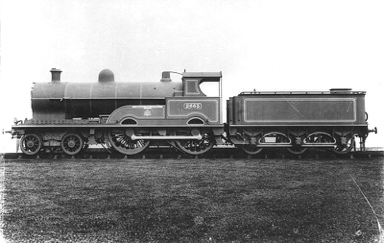
Interwar
1914
- 1939
Feb
1934
The idea of starting a Women’s Institute in the Stowes was born. Twenty-eight women with the help of Mrs Baker from Northampton County Federation, formed an Institute with Miss Starmer as President.
25
Feb
1935
The depression continued in Britain with the unemployment rate reaching 20%
Birth of radar
In a field below Upper Stowe radar was demonstrated for the first time in Britain. Robert Watson Watt and Arnold Wilkins showed that aircraft could be detected by bouncing radio waves off them. It was radar, more than any other invention that saved the RAF from defeat in the 1940 Battle of Britain. A memorial to the Birth of Radar can be seen on the road to Litchborough below the village.
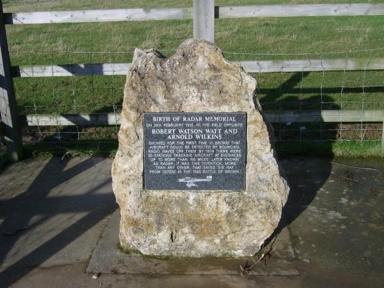
Second
World War
1939 – 1945
World War II was the deadliest conflict in human history, marked by 50 to 85 million fatalities.
It directly involving more than 100 million people from over 30 countries
The village played its part in the Second World War:
Sgt Plt Cyril Tomlin killed in action
The Rectory (now Wyndham House) was used as a school for Padrés, the high walls and local terrain being ideal for the battle courses which were part of their training.
The army also commandeered the drive and park at Stowe Lodge for manoeuvres
Stowe families were hosts to evacuees from the London area.
A Home Guard Unit had a hut near Stowe Lodge
At least 4 villagers went into the Royal Air Force
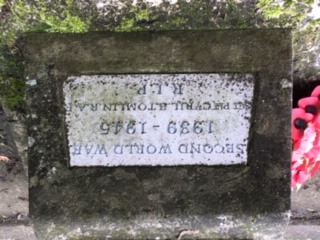
Postwar
1945
- 1999
1947
The Manor was the first house to be connect to the mains electricity supply.
1951
Ferranti Ltd start to produce the world’s first commercially available computer. 1951
A pageant is held to celebrate 1000 years of
local history. Historic enactments in period costume were performed. The event was organised by Miss Sylvia Starmer who lived her whole life in Stowe until after her 100th birthday
21st Sept 1951
The 08:20 Liverpool Lime Street to London Euston passenger service began to de-rail south of Weedon at a speed of 65 mph, finally crashing and killing 15 people and injuring 35 more.
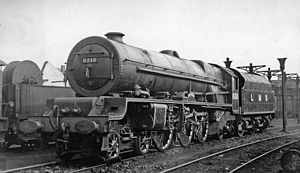
1952
6 February – King George VI dies at Sandringham House aged 56
The mains water supply was connected to the village
1953
Coronation of Queen Elizabeth II
The village school closes after 112 years
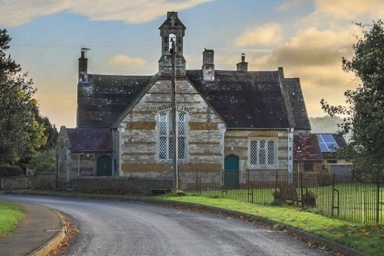
1959
The M1 motorway opens
The Stowe Nine Churches Gardeners’ Club commences
1982
Falklands War begins as Argentina invades the Falkland Islands
Eleven and a half tons of Church Stowe limestone are said to have been used in repair work at Cannons Ashby Church and House
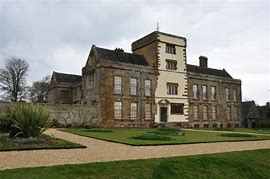
21st Century
2002
Queen Elizbeth’s Golden Jubilee
Princess Margaret dies on 9th February at the age of 71
30th March, the Queen Mother dies at the age of 101.
Sharon Goble becomes the first women Rector

2017
Manchester Arena attack – 23 people killed and more than 500 injured
Grenfell Tower fire – killing 72 people
St Michael’s is listed amongst the 100 best churches in Northamptonshire by Northamptonshire’s Best Surprise
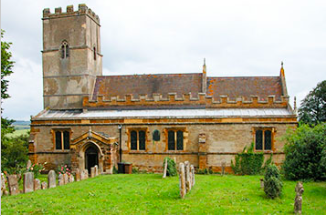
2018
29 Jul
Britain struggles politically with Brexit uncertainties
Major
structural problems are discovered in the Church; cracks in the
masonry, deterioration to the roof’s integrity and problems
with loose masonry in the tower (belfry)
An event is held in St Michael’s to launch the restoration appeal
